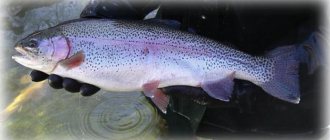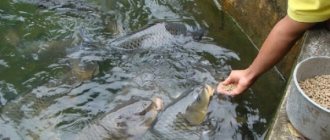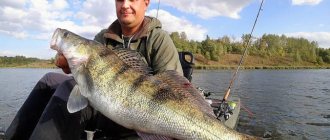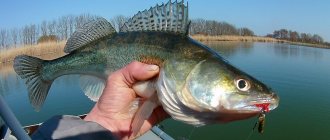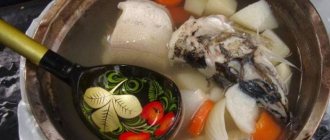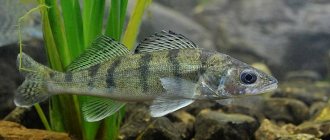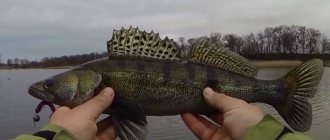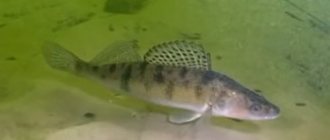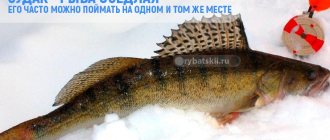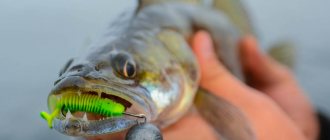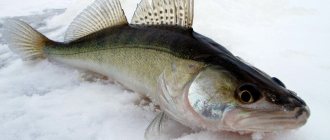River pike perch is a voracious, medium-sized freshwater predator. He is very active, but during the hunt he is able to sit in ambush for more than one hour, showing exceptional patience. You can meet pike perch in the rivers and lakes of Europe and Asia; some individuals go downstream and populate river deltas and desalinated bays of the Black, Caspian and Azov seas.
Currently, pike perch is increasingly becoming an object for artificial breeding in fish farms. It is able to efficiently consume food and produce the greatest annual weight gain for the same amount of food compared to other freshwater predators.
What does pike perch fish look like?
The appearance of pike perch suggests that it is a carnivorous fish:
- An elongated, laterally flattened body and a flat, elongated head allow it to rapidly increase speed while jumping for prey.
- Pike perch has excellent vision and almost complete all-round visibility thanks to its rotating, bulging eyes.
- Small scales fit tightly to the body.
- The structure of the mouth allows it to capture large prey. Pike perch teeth have two pairs of fangs on the upper and lower jaws, which makes it possible to securely hold caught fish, frogs or river crustaceans.
- The body of the pike perch has a silver-brown tint with a greenish tint on the back. Dark transverse stripes are visible on the sides, the surface of the fins is covered with dark dots. This color makes pike perch almost invisible in thickets of coastal reeds, algae, and other natural shelters.
Sea fish pike perch
Visually, sea pike perch differs very little from its ordinary relative. The body is colored light gray; transverse dark stripes are clearly visible on the sides.
In general, the description of the fish pike perch is also true for sea pike perch. The only difference is in size. Although the body length is quite respectable (50-60 cm), body weight usually does not exceed 2 kg. This is because his body is very elongated and flattened on the sides. The jaws also have fang-like teeth, but not at all as impressive as those of the common pike perch.
There are two isolated habitats for this species, giving us essentially two separate populations. The first population lives in the northwestern part of the Black Sea, where such large rivers as the Dnieper, Southern Bug, Dniester and Danube flow into it. Moreover, the local pike perch not only love to enter freshwater estuaries, but are their permanent inhabitants. Sometimes they even swim directly into river mouths.
The second population lives in the Caspian Sea. The local pike perch have some minor differences in appearance from the Black Sea ones. In addition, Caspians, on the contrary, avoid appearing in desalinated areas of the sea, for example, near the Volga delta.
What is the difference between bersh and pike perch?
Pike-perch, bersh and perch
Pike-perch are sometimes confused with relatives belonging to the same family. The bersh, or Volga pike perch, has the greatest external similarity to the common pike perch. Beginning fishermen often do not distinguish between these related fish breeds, mistaking the bersh for a young zander. At first glance, both types look almost the same, but upon closer inspection you can see the difference between them:
- The head of the Volga pike perch is shorter and wider, the eyes are larger.
- It has larger scales that cover not only the body, but also part of the gill covers.
- The teeth on both jaws are almost the same length.
- The dorsal fins of the bersha are higher with rounded edges.
Where are pike perch found?
The habitats of pike perch are deep rivers, reservoirs and lakes with running water. The predator prefers areas with a hard sandy or rocky bottom and large underwater objects: snags, large boulders, bridge supports, submerged trees. The traditional pike perch place is the edges of steep holes with an uneven bottom. Young animals may approach the coastal zone while hunting; older and larger individuals prefer the deepest places in the reservoir.
Pike perch does not change its habitat throughout the year, with the exception of the spawning and wintering periods. Before the first frost, the fish gather in schools and lie at a depth of 10-12 meters. The flock disbands only in early spring, when adult individuals leave for spawning.
How and where to catch pike perch and when is the best time to do it?
The arsenal of baits for pike perch is probably second only to pike baits. Jig heads, retractable leash, minnow wobblers, spinners, foam fish - this is just an incomplete list of what can (and should) be in fishing boxes. Depending on the fishing conditions, spinning rods with various tests, from ultralight to heavier river rods, are successful. Reels ranging from 2000 - 3000 sizes according to the Shimano classification, a thin braided cord (0.12 - 0.14 mm), a fluorocarbon leader and a set of baits that pike perch like in a particular body of water - these are the standard “weapons” of the average pike perch angler.
You can catch pike perch throughout the year, with the exception of the period of spawning and recovery after it. Much will depend on where the fish are at this time of year. In spring and autumn, it is better to look for pike perch in shallow water and in places where there is a difference in depth. In winter and summer heat, it’s better to try your luck at the depths and in the surrounding area
What does pike perch eat?
The predator's diet includes food exclusively of animal origin. Young pike perch feed on leeches, worms, insects, mollusks, caviar; adult fish choose larger prey: frogs, crayfish, fry and young fish of suitable size. There are often cases when smaller representatives of their own species become food for a grown-up predator. Due to the peculiarity of the structure of the mouth, pike perch chooses fish with a long, elongated body.
The pike perch's mouth, esophagus and stomach are durable, elastic and stretchable. This structure allows even quite large prey to be swallowed whole. The skeleton of pike perch has the following feature: all the organs of the digestive system are located in the upper part of the body, while the abdomen remains empty. The food entering the body fills the stomach, which increases in size and takes up all the free space.
Having filled its stomach, the pike perch goes to a parking lot in a secluded place and remains there until the food is completely digested, after which it goes hunting again.
Unlike other predatory fish, pike perch does not pursue its prey, but uses wait-and-see tactics. Having chosen a place for an ambush, it hides behind algae, snags or large stones and freezes in anticipation of its prey. At the sight of prey, the pike perch makes a lightning-fast throw, capturing it with sharp fangs.
General information about the species
Many fishermen are still debating whether pike perch is a sea or river fish, dividing into two groups with different points of view. Representatives of the first group claim that this predator is found only in fresh water, preferring rivers and lakes.
In turn, the second group of people holds the opposite opinion, pointing out that this inhabitant of the depths feels quite comfortable in water with high salinity. Science confirms two theories, and this is not surprising.
The fact is that pike perch belongs to two biological forms of existence - residential and so-called semi-anadromous fish. Residential fish constantly stay in fresh water, and semi-anadromous creatures spend a significant part of their time in the estuarine areas of the seas, but go to the lower reaches of rivers to spawn.
Currently, the taxonomic classification distinguishes several varieties of pike perch:
- Ordinary.
- Volzhsky (bersh).
- Nautical.
- Lightfeather (yellow).
- Canadian (sandy).
The last two species are found mainly in the regions of North America, and in Russia the Volga and common pike perch . When wondering where sea pike perch is found, keep in mind that the main distribution of such specimens is concentrated in the waters of the Caspian Sea and the northwestern parts of the Black Sea.
Unique characteristics
Pike perch is a truly unique inhabitant of the deep waters, which has a lot of special properties and characteristics. Of particular note are the following:
- Pike perch is a valuable commercial fish, but recently the catch has been significantly limited due to the rapid decline in the population.
- The weight of the largest individuals reaches 18 kilograms with a body length of 1.3 meters. Moreover, such individuals live up to 14 years.
- The fish are almost not exposed to diseases.
Sea and common pike perch are valuable representatives of the fauna of reservoirs . And although they have practically no striking differences, some individual characteristics are still present.
Zander spawning
The timing of puberty in pike perch depends on living conditions. In the temperate climate zone, males and females are ready for reproduction at 3-4 years of age. In the northern regions, fish ripening occurs with a delay of 1.5-2 years. Light-finned pike perch, which lives in reservoirs with cold water, begins to spawn only at 7-8 years of age.
The period when pike perch spawns begins when the water warms up to +10-12 degrees. The fish move to shallow water with a lot of vegetation. The female lays eggs in the dark, laying them in small portions on the leaves and stems of plants. Pike perch caviar is very small (the diameter of the eggs does not exceed 2 mm) and has a light yellow color.
After the end of spawning, the predator does not guard the spawning site, but immediately goes to its usual hunting grounds. No more than 1 percent of the offspring survive to the first year. Most of the eggs and hatched fry die or become prey.
Nutrition and reproduction
The diet consists exclusively of animal feed. Juveniles consume aquatic invertebrates, worms, crustaceans, leeches, and eggs. Growing and large pike perch eat mainly frogs, crayfish and fish. In search of food, regular migrations take place along the same paths and places. During the current, the predator often waits for prey in a shelter, after which it suddenly attacks. The feeding activity of fish continues around the clock throughout the year, with the exception of spawning.
When does pike perch spawn?
The breeding season occurs in April-May, when the water heats up to a temperature of +12-13°C. Mature individuals participate in the process, starting at the age of 3-4 years. Shallow water areas with a bottom littered with roots, snags, and stones are selected as spawning grounds. In such places, the female forms a clutch of 200-500 thousand yellow eggs with a diameter of 1-1.5 mm, which are tightly attached to the substrate. A special feature of pike perch spawning is the nesting method. To protect the eggs from being eaten by other aquatic inhabitants, the male remains near the nest and guards it until the larvae hatch.
To learn more:
Amur catfish - description and characteristics of fish
The initial food is zooplankton. But very soon the fry grows to 3-6 cm in length and already hunts the offspring of other fish. If there is no suitable food nearby, a mass death of young animals begins. This largely explains why, given the high fertility of the species, the population of pike perch is never too large. On the contrary, in many reservoirs there is always an acute shortage of this representative of perch.
How does pike perch grow?
Pike perch larvae appear 5-8 days after spawning. The speed of their maturation depends on the degree of heating of the water. In the first weeks, food for the young is zooplankton, insect larvae, and eggs of other fish species. After 5-6 weeks, fry are formed from the larvae, the length of which reaches 8-10 mm. At this stage of development, pike perch acquires the appearance and color characteristic of adults. The growth rate of a predator is determined by its habitat conditions and the volume of its food supply.
In the first months of life, young animals gather in numerous schools, later their number is limited to 15-20 individuals. Often individuals of different ages and sizes can hunt in the same flock.
The predator is considered one of the largest fish in its family. The maximum weight of pike perch under favorable conditions can reach 15 kg. How long pike perch lives depends on its lifestyle and habitat. It is believed that the average life expectancy of a predator is between 10-12 years.
Fishing Features
You can go fishing for pike perch at any time of the year. More successful periods for fishermen are the spring feast before and after the end of spawning, as well as the autumn feast before the flocks leave for the winter.
The activity of the predator is the same throughout the day: as soon as the next portion of prey is digested, the pike perch goes hunting. The bite may decrease during the day in extreme heat, but as the temperature drops in the evening, activity resumes. You can fish the chosen place from a boat or shore. To catch trophies from the shore, the following fishing methods are used:
- On a spinning rod - casting a spinner or wobbler, imitating the behavior of a real live fish.
- For bottom gear , live fish (live bait) are used as bait.
When fishing from a moving boat, several spinning rods are thrown at once to fish a large area. This method is called trolling and is suitable for catching pike perch at shallow depths.
Trolling
Depending on the season, live bait, wobblers or spinners are used as bait. It is recommended to attach several hooks to leashes above the bait level.
The capture of bait by pike perch does not occur particularly sharply. Usually the hook goes into the jaw or mouth, so you should hook the fish sharply. The predator usually resists at the very beginning of fishing. He tries to rest against the bottom, struggles and strongly pulls the line, but pretty soon the resistance weakens and the caught fish can be pulled ashore with almost no difficulty.
When choosing gear and fishing location, it is necessary to take into account the habits of pike perch, the topography of the reservoir and the season.
Pike perch in cooking
The predator has tender and lean white meat. The calorie content of 100 grams of fillet is only 84 kcal. The high percentage of protein in the product ensures the nutritional value of dishes prepared from it. Pike perch meat contains practically no fat, so it is quite suitable for dietary nutrition.
Pike perch is rich in phosphorus, iodine, fluorine, potassium, iron, cobalt, and vitamins. Meat contains amino acids (including essential ones), as well as polyunsaturated fatty acids.
Carcasses can be frozen for storage for several months. When frozen they will retain all their beneficial properties.
The meat of young fish, whose weight does not exceed 2.5 kg, is considered the most delicious and juicy. At an older age, the predator may develop an unpleasant taste that smells like mud.
Pike perch is not a bony fish, so it is suitable for preparing a wide variety of dishes. They make fish soup and aspic from it, bake it whole, stew it and fry it in portions, stuff it, and use it as a filling for pies. Cutlets, meatballs and casseroles are prepared from chopped pike perch fillets.
Interesting facts about pike perch
- The largest pike perch in Russia was caught on the Kama River. The weight of the predator was 12.5 kg.
- Pike perch is sensitive to oxygen levels, so it is not found in bodies of water with polluted water. The presence of fish in a river or lake indicates their relative purity.
- Pike perch meat contains more protein than chicken meat.
- The inner surface of the predator's eye shell is covered with cells filled with guanine, which allows the fish to see well in the dark. Guanine reflects light, so in bright light it appears that pike perch are white-eyed.
- You can determine the sex of a fish by the size of its fangs: in males they are noticeably larger.
Life cycle of pike perch
Puberty of pike perch occurs at 3-5 years of age. A mating union includes one female and several males, with only one of them having the right to mate. Subsequently, this male guards the eggs until the small fish are born. Young animals gain weight very quickly and even at a young age can consume the same juveniles of other fish species. The size of pike perch fangs is one of the distinguishing features of the sexual difference between females and males. Males have larger fangs. Pike-perch have a high life expectancy, sometimes their cycle reaches 15 years.
